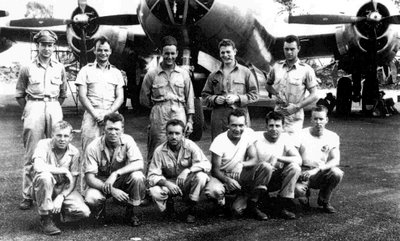
BACK ROW, LEFT TO RIGHT:
Marvin S. Watkins, William R. Fredericks, Howard T. Shingledecker, Charles M. Kearns, Dale E. Plambeck
FRONT ROW, LEFT TO RIGHT:
Robert C. Johnson, Teddy J. Ponczka, Robert B. Williams, Leon E. Czarnecki, Leo C. Oeinck, John C. Colehower
On May 5, 1945, an American B-29 bomber was flying with a dozen other aircraft after bombing Tachiaral Air Base in southwestern Japan and beginning the return flight to the island fortress of Guam.
The prisoners were eight American airmen, knocked out of the sky over southern Japan during the waning months of World War U, and then torn apart organ by organ while they were still alive.
One of the Americans died when the cords of his, parachute were severed by another Japanese plane. A second was alive when he reached the ground. He shot all but his last bullet at the villagers coming toward him, then used the last on himself.
Two others were quickly stabbed or shot to death.
At least nine were taken into custody.
B-29 crews were despised for the grim results of their raids. So some of the captives were beaten.
Teddy Ponczka was the first to be handed over to the doctors and their assistants. He had already been stabbed, in either his right shoulder or his chest. According to Tono, the American assumed he was about to be treated for the wound when he was taken to an operating room.But the incision went far deeper. A doctor wanted to test surgery's effects on the respiratory system, so one lung was removed. The wound was stitched closed. Tono remembers events differently. The first experiment was followed by a second, he says. Ponczka was given intravenous injections of sea water, to determine if sea water could be used as a substitute for sterile saline solution, used to increase blood volume in the wounded or those in'shock. Tono held the bottle of sea water. He says Ponczka bled to death
No comments:
Post a Comment